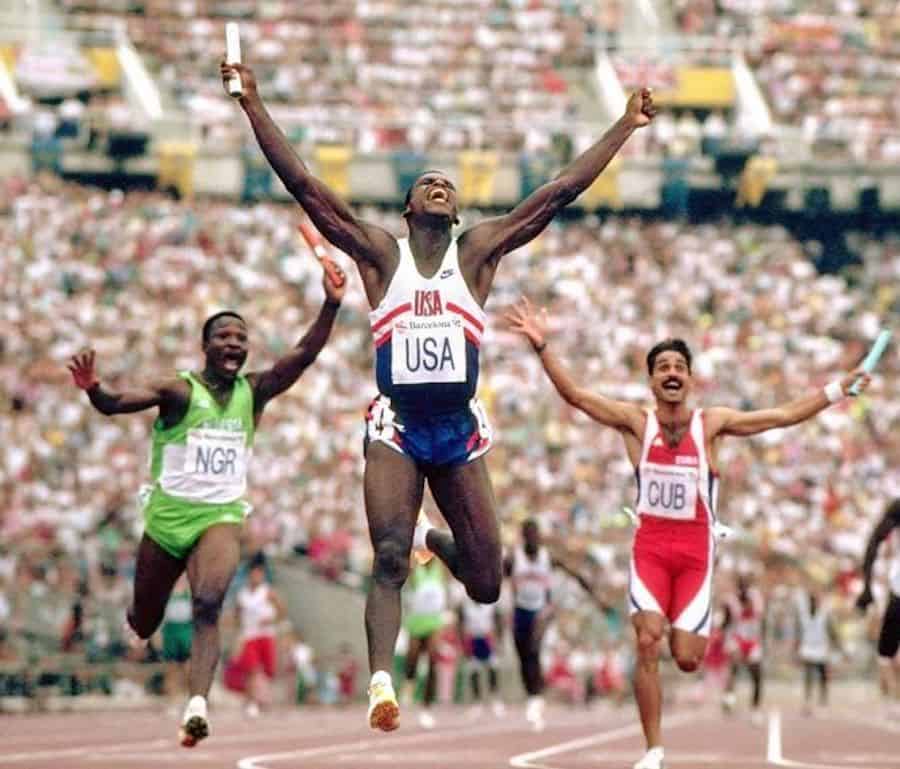‘And all that I knew was the hole in my shoe which
Was letting in water’, (Traffic, 1967)
I blamed Carl Lewis.
There I was, on the steps of the old Parliament House in Canberra, squinting into the sun and trying to explain to a national television audience on the Today show that, yes, the world’s greatest athlete wasn’t coming, but no, the World Cup would not hence be cancelled.
And all that I knew was the hole in my shoe, which was letting in water. Today was presented on Channel 9, hosted Steve Liebmann. I was doing a live cross from Canberra. And the producer had decided he’d get the best vision by asking me would I mind standing with one foot in a shallow puddle.
Guess which one of my shoes had the hole in the sole?
It wasn’t really all Carl’s fault, though he, or his people, had agreed to be available for the USA 4×100 metres relay for the World Cup in Canberra. Until then, it had looked as if he wouldn’t come at all. After winning four gold medals at the previous year’s Los Angeles Olympics, TWGA (the world’s greatest athlete) had decided to take it low-key in 1985.
That meant no US championships and that, in turn, meant no spot for Carl on the World Cup team. Until some genius in the World Cup local organising committee decided we could get TWGA to Canberra if a vacancy could be created in the relay squad.
Of course, nobody checked whether the spot which apparently was available really was available. Lewis joined the team in Tokyo before it came to Australia but someone _ either the athletes or the team coach _ demanded he come to relay training and, when he did not, he was off the team again.
So now, instead of TWGA simply being unavailable for the World Cup, we _ which that sunny spring morning meant me _ had to explain why he was first, coming, and then, not coming to Canberra.
The will-he/won’t-he question was a disconnect for me anyway. I came to be working in the Canberra World Cup marketing section because my boss recognised that she knew a lot about marketing and promotion but nothing about athletics, and therefore needed a mirror opposite. Knowing nothing about marketing and a little about athletics, I fit the bill.
As an athletics nut, all I could see was regardless of whether Carl Lewis, Sebastian Coe and Steve Ovett _ to name but a few _ turned up, over 400 of the world’s best athletes were coming. Australia had been starved of world athletic talent on this scale since the 1956 Melbourne Olympic Games. Whoever came, it would be a feast.
I worked for the World Cup Local Organising Committee for nearly 18 months, and it was a thoroughly enjoyable experience. In the course of it I travelled to the European Cup in Moscow and the aftermath (unfortunately) of the African championships in Cairo.
At the former, I had very little to do. I judged it wasn’t exactly politic to file stories about athletes who might, or might not, come to Canberra.
Moscow was then a micro-controlled environment; Cairo a chaotic one. At baggage claim, locals clambered right on to the carousel and tossed carpet bags out to waiting friends or family members. On the street, traffic moved intermittently, horns blared constantly.
We had a meeting with the African delegation, headed by the imposing figure of Lamine Diack. The treasurer, I was warned, had placed a gun on the table at a previous meeting, saying that he couldn’t carry the cash without ‘security’. This time, mercifully seeing we were discussing finance, he came unarmed.
The LOC thought it was organising the Cup, but the IAAF had other ideas. The original dates were 5, 6 and 7 October, the latter falling on a bank holiday Monday. The IAAF insisted that the dates be amended to 4-6 October for European television. I still have posters and stationery with the original dates!
The competition was fantastic, culminating in two world records by East Germans _ Marita Koch in the 400 metres and the women’s 4×100 relay _ on the final day. Both still stand and we now know to be shrouded in suspicion, but they were still spectacular. Speaking of future drug scandals, Ben Johnson won the 100 metres on day one in an all-comers’ record of 10.00.
Then, the World Cup was fondly regarded by athletics fans. It had been the forerunner of the world championships, with editions in Dusseldorf (1977), Montreal (1979) and Rome (1981) before the IAAF staged its first world championships in Helsinki in 1983.
My first link with the Cup was in Montreal, where I ran the associated World Cup marathon, finishing one place behind Bill Rodgers (he had a bad run, mine was a pretty good one). Then came Canberra, and in 2006 I was invited to Athens to provide coverage for the Oceania region. On a huge final day Craig Mottram, Steve Hooker and Valerie Vili all won, Mottram defeating Kenenisa Bekele to win his second consecutive World Cup 3000.
In Split last weekend the World Cup had morphed into the Continental Cup, with a revised format of two per team per event. It was refreshing to hear Steve Hooker say there appeared to be widespread acceptance of the changed concept among athletes. Maybe the IAAF has got it right.
The IAAF got something right back in 1985, too. The day after the Cup, the Monday the LOC had wanted as the final day, it poured non-stop. Instead of finishing with two world records, the 1985 World Cup would have squelched to a close.
And I would probably have been wearing the shoes with the hole again.

Comments are closed.